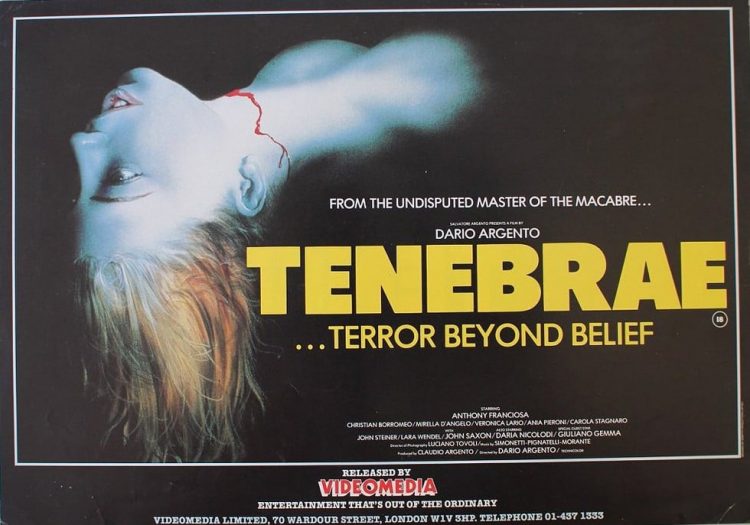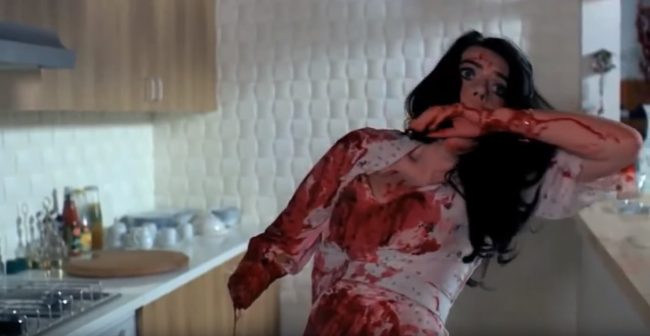
While perhaps better known for his supernatural horror movies, particularly the Three Mothers trilogy, Italian director Dario Argento did some of his finest work in a sub-genre known as giallo, straight-forward horror/mystery films featuring over-the-top murder scenes. His most famous gialli is 1975’s ‘Deep Red.’ However, it may not be his best one. I feel his finest gialli, if not finest film overall, is 1982’s ‘Tenebrae,’ a nail-biter of a whodunit combined with a serious dollop of blood and guts.
Anthony Franciosa plays Peter Neal, a suave American writer whose suspense novels are a big hit in Europe. He ends up in Rome on a promotional tour. Rome proves to be problematic for Neal. Someone has decided to start killing young women using some of the same methods Neal uses in his books. The killer is obviously proud of his work, for he sends Neal a letter citing him as the inspiration for the killings. Neal alerts his inner circle, literary agent Bullmer (John Saxon) and assistant Anne (Daria Nicolodi). The police are notified and, while it is a pain, Neal gives them his full cooperation.
Meanwhile, the suspect pool starts to expand. Could the killer be Neal’s ex-wife, Jane (Veronica Lario), who has followed Neal to Italy without his knowledge? Could it be Berti (John Steiner), the television talk show host who feels that Neal’s books border on obscenity? Or could it be someone even closer to Neal than he dare surmise?

‘Tenebrae’ is a fast-paced, tension-filled mystery. The situation of having a crazed stalker killing in order to get someone’s attention is “ripped from today’s headlines,” to be sure, but ‘Tenebrae’ is designed to frighten, not lower the moral boom on anyone’s head. There’s no moral. There’s no happy ending. The film is built for discomfort. If that’s what you’re after, strap in. It’s a delightfully bumpy ride.
More so than most other Argento films, ‘Tenebrae’ features relatable characters with some depth, not simply silhouettes or archetypes. Franciosa and Saxon turn in dependably seasoned performances which, if not nuanced, are layered enough to make everything going around them believable. Nicolodi is restrained, playing a mousier-than-usual character, but guess what? She’s still hot. And while you normally have to check your desire for logic at the door when watching an Argento film, ‘Tenebrae’ stays remarkably grounded in reality and physics, making it an excellent entry point for newcomers to the Argento oeuvre.
In terms of the plot itself, the movie is incredibly compelling. It doesn’t meander off into meaningless subplots. Even when the plot decides to chase some fringe characters around for a while, it is always for a reason. Everything loops back around to form a cohesive whole. It’s solid.

If you’ve never seen an Argento film before, be warned of this: the blood is never the right color. It always looks like latex paint that you would never put on any wall of your own. That being said, there is off-color bloodletting by the gallon in ‘Tenebrae.’ Gore fans will be satisfied, as will those who are susceptible to jump scares. There are quite a few shocking moments in the movie, skillfully woven into the overall story. Nothing seems gratuitous and nothing feels like it’s hanging loose. ‘Tenebrae’ also features some amazing camera work utilizing the then-new Louma crane. There is a tracking shot in this movie, following the tenants of an apartment from the outside, as they walk from window to window on two separate levels of the building. Not a cut, not a twitch. It’s an incredible shot, the kind of thing we only see nowadays from David Fincher and his computer graphics geniuses.
More bound by linear time than perhaps any other Argento film, ‘Tenebrae’ offers the viewer a well done story with good acting and, for good measure, a heaping helping of arterial spray. The surprise ending truly is a surprise, in more than ways than one. This is a foreign horror movie you can bring home without worrying about it being “too foreign,” thanks to the presence of some recognizable American actors and some good dubbing. It isn’t too culture-centric as to be unenjoyable without a serious knowledge of Italian history, which can be a turn-off to some film neophytes.
Still here? Good. A couple more things.
There’s some confusion concerning the spelling of the movie’s title. While some DVD covers have the film’s title as ‘Tenebre,’ the title card on the film itself reads ‘Tenebrae.’ You may run across some very old copies of this movie under the original US title, which is ‘Unsane.’ Avoid watching the movie under this name, as it is missing a good ten minutes.
Also, if you’re reading this article in Germany, this movie is reportedly still banned there. ‘Tenebrae’ was one of the infamous Video Nasties, outlawed in the UK during the Eighties. And while that ban has been lifted in England, The German Censorship Board claims ‘Tenebrae’ will never be released uncut in Germany. A movie that can still have that kind of effect on a nation almost thirty years after its original release is certainly a film you need to see.
